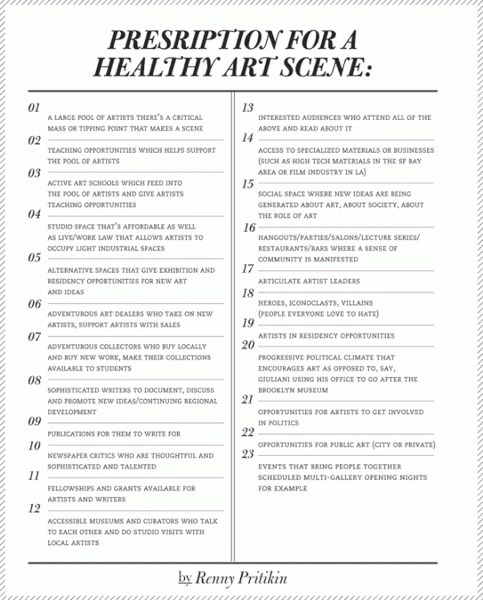Scanning through some museum-related articles from a clipping service, I did a bit of lateral research on my own and came upon this manifesto-like document. The list of preconditions for a healthy art scene was part of a blog post on why artists leave San Francisco for the "Big 4" (New York, Los Angeles, Chicago and Miami). Here in the Battlefords, it may be hard to imagine how artists in a cultural centre like San Francisco might feel that they're too far off the map to get the kind of financial and critical support they need to maintain viable practices.
Canada is sparsely populated and has only recently developed a patron-class that looks to its own. That's the fundamental raison d'锚tre for establishing public funding bodies like the Saskatchewan Arts Board and the Canada Council for the Arts.
It's at least a partial truism that art can only flourish in centers that have amassed such fantastic concentrations of wealth and density that buyers and taste-makers will try to outdo each other by supporting incredible work that, in rare instances, is able to make history and change the way we see things.
Of course this rule-of-the-centre can't be accepted if we believe North Battleford has great artists and the potential to nurture an art community that makes national and global contributions.
The "Prescription for a healthy art scene" is worth looking at. While it's good to have local patrons who buy local art, only two of the 23 points call for more sales. Patronage is complex and consists of a web of support avenues that build interest, awareness and value for art. Talk is crucial. One of the over 90 replies to Pritikin's blog-post laments the "Dude I just like to draw" syndrome. This assumes that great art needs no explanation. It's completely self-sufficient and will be recognized and appreciated simply because it is great. What this doesn't take into account is that 'greatness' looks different depending on where and when you live. It's a dynamic quality and like value, it needs to be instilled and nurtured.
And how does that happen? Look at Pritikin's other points. Close to half involve education, writing, publication and opportunities for artists to gather and generate a sense of community, articulate regional and cultural characteristics and position themselves in the world with awareness and a sense of themselves as players.
The Allen Sapp Gallery is a treasure for North Battleford and a wonderful resource for students, citizens and visitors from around the world. Many artists take inspiration from the work and accomplishments of Allen Sapp. Exhibitions at the gallery are generally presented over long periods, allowing for deeper research and greater development of the educational components. Artists in the region who are interested in contemporary modes of art-making - even those who integrate traditional forms of cultural and artistic knowledge - need more models.
That's where the Chapel Gallery comes in. The Chapel features contemporary art in all media and disciplines. Exhibitions of installation-art and video-projection are quickly followed by landscape painting, new work by Aboriginal artists and crafts. It hosts workshops, artist-talks, symposia and more recently, listening-parties (check out the new and improved North Battleford Galleries Newsletter for more information). The Chapel is not only a crucial venue for regional artists - it's a seed-bed.
Richard Florida, a professor at the Rotman School of Management, is well-known (and well-paid) for his claims that a healthy and vibrant "creative class" is at the heart of all great cities and communities.
Urban renewal initiatives, adaptive reuse schemes and municipal programs that enhance quality of life and encourage business and industry, all need to look to artists. The old story of neighbourhood rejuvenation is an object lesson for Florida's ideas.
Artists move into a run-down area of town, because it's cheap to live and cheap to work (also, because no one else is interested - it's cool). They fix things up, hold events, bring people in and attract new businesses. The rest of the story isn't as rosy - for the artists, that is - new developments and higher rents eventually push them out.
But if the main preconditions outlined in Renny Pritikin's "Prescription for a healthy art scene" are in place, the cycle starts again in another area of town.
With the high value North Battleford places on art through its galleries, the Dekker Centre for the Performing Arts and the host of musical, theatrical and other cultural events, it is laying a strong foundation to attract new investment and the kind of people who believe that great communities start with art.




